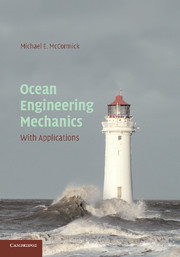Book contents
- Frontmatter
- Contents
- Preface
- Notation
- OCEAN ENGINEERING MECHANICS
- 1 Introduction
- 2 Review of Hydromechanics
- 3 Linear Surface Waves
- 4 Nonlinear Surface Waves
- 5 Random Seas
- 6 Wave Modification and Transformation
- 7 Waves in the Coastal Zone
- 8 Coastal Engineering Considerations
- 9 Wave-Induced Forces and Moments on Fixed Bodies
- 10 Introduction to Wave-Structure Interaction
- 11 Wave-Induced Motions of Floating Bodies
- 12 Wave-Induced Motions of Compliant Structures
- Appendices
- References
- Index
12 - Wave-Induced Motions of Compliant Structures
Published online by Cambridge University Press: 05 June 2012
- Frontmatter
- Contents
- Preface
- Notation
- OCEAN ENGINEERING MECHANICS
- 1 Introduction
- 2 Review of Hydromechanics
- 3 Linear Surface Waves
- 4 Nonlinear Surface Waves
- 5 Random Seas
- 6 Wave Modification and Transformation
- 7 Waves in the Coastal Zone
- 8 Coastal Engineering Considerations
- 9 Wave-Induced Forces and Moments on Fixed Bodies
- 10 Introduction to Wave-Structure Interaction
- 11 Wave-Induced Motions of Floating Bodies
- 12 Wave-Induced Motions of Compliant Structures
- Appendices
- References
- Index
Summary
Compliant Structures
Fixed ocean structures fall into three major types: rigid structures, compliant structures, and spread-footing structures. There are also two hybrid types of structures, called the tension-leg platform (TLP), which is a floating body held in place by high-tension mooring lines, and the articulated-leg platform (ALP), which is a quasi-rigid cylindrical hull attached to a universal joint on a sea-bed foundation. Rigid structures are usually designed for near-shore operations. Drilling structures used to tap the oil deposits in the shallow near-shore waters are normally of this type. As oil exploration moved further offshore, rigid structures became expensive and their cost-effectiveness decreased. To reduce drilling costs in the deeper water, compliant towers were constructed. One such structure is the Lena guyed tower, which was deployed in the Gulf of Mexico in waters of about 300 m in the 1980s. One advantage of the compliant structure is that its foundation is much less expensive compared to that of the rigid structure. The reason for this economy is that the wave loads are partially absorbed by the elasticity of the structure. In the North Sea, where severe storms occur over the entire year and the waters are relatively shallow, the spread-footing structure has been used to tap oil and gas deposits beneath the sea bed. These structures are monolithic structures, and simply rest on the bed. The structural load is distributed over the soil, reducing the normal load on the bed.
- Type
- Chapter
- Information
- Ocean Engineering MechanicsWith Applications, pp. 453 - 528Publisher: Cambridge University PressPrint publication year: 2009



